

|
Soundclip:
|
| See Steve's Hand-Written Solo
Transcription |
|
Steve Grossman's solo on: "Right Off"(Miles Davis) Though I have, no doubt, stated this before at these pages, it doesn't seem like so long ago that I was in college at U.C.L.A. and, like all fans of the great Miles Davis Quintet, which featured: Wayne Shorter(Tenor Sax); Herbie Hancock(Ac. Piano); Ron Carter(Ac. Bass); and Tony Williams(Drums), I couldn't wait for the next LP to be released. Even when the rhythm section changed, and those three giants were replaced by: Chick Corea(Ac. Piano); Dave Holland(Ac. Bass); and Jack DeJohnette(Drums), my interest never waned. I was still fascinated as we entered the Electric Jazz Era, the Jazz-Rock Fusion Era, and Miles released albums like: "IN A SILENT WAY," "BITCHES BREW," "BIG FUN" and others. 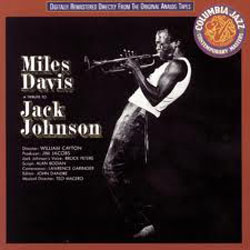 But, as it is with all things, my tastes changed, and I began to drift away and to enjoy other artists. When Miles Davis' "A TRIBUTE TO JACK JOHNSON"(Columbia) was released in February of 1971, I bought it, gave it cursory listening, and put it away, never paying much serious attention to it. When one does that, there's always the risk that you just might have missed something, even missed a gem! But, as it is with all things, my tastes changed, and I began to drift away and to enjoy other artists. When Miles Davis' "A TRIBUTE TO JACK JOHNSON"(Columbia) was released in February of 1971, I bought it, gave it cursory listening, and put it away, never paying much serious attention to it. When one does that, there's always the risk that you just might have missed something, even missed a gem!Around the time of "IN A SILENT WAY," the role of producer, Teo Macero, began to take on greater weight and importance, as the process of editing together pieces of takes, performances grew into what would come to be viewed as "works of art" in many circles. In many ways, some of his editing was brilliant. Of course, as fans, we never knew what we were actually missing, because the "performance" we were hearing was all that we knew. In other words, how can one miss what one hasn't ever heard? I don't own "THE COMPLETE JACK JOHNSON SESSIONS" on CD, but I did do some brief research via the Wikipedia page for the recordings, and discovered some interesting information. As we are presenting Steve Grossman's fantastic soprano sax solo from the spliced-together piece titled, "Right Off," it's worth it to note that these fragments were recorded in Columbia's Studio 'B' on April 7th, 1970 by a group that featured, in addition to Miles and Steve Grossman: Herbie Hancock(Organ & El. Piano); John McLaughlin(El. Guitar); Michael Henderson(El. Bass); and Billy Cobham(Drums). According to the logs kept, there were 4 takes of varying lengths, and the final result was one edited together performance, 26:53 in length. As it does on the actual released recording, Grossman's solo is faded in, and transitions into, of all things, a Herbie Hancock Farfisa organ solo!!! After my move to New York in January of 1970, I began to come in contact with the community of younger musicians that was growing by leaps and bounds, and there many transplants to this great city just like me. Upon arrival, I suppose that I had convinced myself that I knew something about music, something about the guitar, and New York quickly slapped me silly with the realization that, in fact, I knew little or nothing about either one. That alone should have sent me packing back to Los Angeles with my tail between my legs. But, I was stubborn, and was not going to be forced out of here over a lacking of talent and knowledge. One of the many musicians whom I came in contact with was keyboardist, Steve Robbins. We had a lot of common musical likes and dislikes, and spent a lot of time together. In those early years, he shared some transcriptions that he had done with me. One of them, believe it or not, was this particular Steve Grossman solo! At the time, I just put it away, because I had no interest in that album, so why look at the solo? Well, sometime later, something cosmic brought me back to the solo, but I couldn't locate Steve's transcription in my files, and so, greatly inspired, I decided to do a transcription myself. Of course, as the years have come and gone, I've been able to refine it thanks to the various available technologies. As I have mentioned before, I am never shy, when needing to double-check a couple of passages, about turning to Andy Robinson's brilliant program called "Transcribe!" which, years ago, Michael Brecker recommended to me. Though I haven't actually listened to the entire piece in decades, I just skimmed through it, and the "jam" actually begins over an E7 chord, and when Miles finally enters at about 2:20, the band tries to follow him, and awkwardly transitions to a Bb7 with the sus4 added at times. No trumpet or sax player wants to be playing on an E7 chord, which puts them in the awful key of F#/Gb7!!! Miles' solo continues until about 10:45 of the track, Macero begins to weave some magical editing trickery, and the band seems to fade-out while Miles continues to play long tones. Then, suddenly, at around the 12-minute mark, Teo fades in Steve Grossman's soprano sax, and off we go on this wonderful adventure around the tonal center of Bb7. I am fairly certain that playing soprano sax all the time, and playing over one chord was not what a brilliant player like Steve Grossman had envisioned for himself when the phone rang, and it was Miles asking him to join the band!!! But, there he was, and it was time to play, and play something he did! As the portion of the solo, that we are allowed to hear, begins, Steve plays a great phrase that vaults to a nice high E-natural, the b5 of Bb7, and this pitch will play a greater role during the course of the solo. However, I began transcribing just after that pick-up phrase, and I suppose that you could say that the transcription begins with his 2nd phrase. Before we get to the specifics of what he actually played, I think that a brief discussion of some of the linear strategies one could pursue or investigate when playing over a one-chord Rock-style shuffle might be instructive for some of my readers. 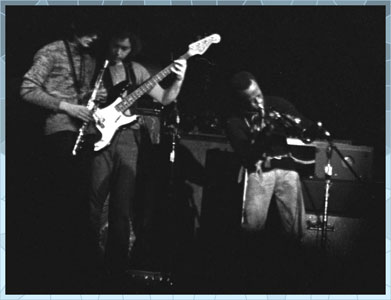 Firstly, the goal of any improvisation or solo, at least intellectually speaking, should be to construct melodic phrases that would, from beginning to end, tell some kind of a story. As there doesn't appear to be any melodic material to draw from here, the soloist is left to his own devices. In this case, is it possible that Steve Grossman listened to what Miles had played, and used some portion of that solo to fashion his own point of departure? Well, as Steve's solo fades in, it's hard to know what his real 1st phrase actually was. Firstly, the goal of any improvisation or solo, at least intellectually speaking, should be to construct melodic phrases that would, from beginning to end, tell some kind of a story. As there doesn't appear to be any melodic material to draw from here, the soloist is left to his own devices. In this case, is it possible that Steve Grossman listened to what Miles had played, and used some portion of that solo to fashion his own point of departure? Well, as Steve's solo fades in, it's hard to know what his real 1st phrase actually was.When you are faced with playing over a static dominant 7th chord, in this case Bb7, you would, of course, have all the blues-based material from which to draw. So, the Bb blues scale[Bb, Db, Eb, E, F, Ab] would be the obvious option. Then you would want to be conversant with the correct modal approach, and the mode for this root would be Bb Mixolydian. However, as I view everything in minor, though the notes are exactly the same, I would see it as F Dorian[F, G, Ab, Bb, C, D, Eb]. If one wanted to expand their harmonic palette, you could employ the F melodic minor scale[F, G, Ab, Bb, C, D, E], which gives you the added dimension of the b5(E-natural). There are those who would use the Bb altered dominant scale which, with a minor point-of-view, becomes B melodic minor[B(b9), Db(#9), D, E(b5), F#(#5), G#/Ab, A#/Bb]. As you can see, this gives you all four of the altered tones, and could give the sense that you might have been headed to a final resolution on an Eb chord of some sort. Except that you never actually arrived there! Another strategy that sophisticated players like to use is to turn Bb7 into a Phrygian sound, and I do this by using Ab Dorian[Ab, Bb, Cb(b9), Db(#9), Eb, F, Gb(#5)]. This gives you three of the four altered tones. Additionally, if you heard it, you could also use the Bb 1/2-tone|whole-tone diminished scale[Bb, B(b9), Db(#9), D, E(b5), F, G, Ab], giving you 3 of the 4 altered tones. And then, you might even try the Bb whole-tone scale[Bb, C, D, E(b5), F#(#5), Ab]. Another approach would be to imagine that you are playing over the V7(alt.) chord of Bb, which would be F7(alt.), and to then apply the Gb melodic minor scale[Gb, Ab, Bb, Cb/B, Db, Eb, F]. You could also imagine the Coltrane ii-V of the b5 substitute B7, by placing an F#m7 or F# Dorian[F#, G#, A, B, C#, D#, E] in front of it. Using these latter strategies puts you in a harmonic and linear position to steer your way back to your tonal center of Bb7. It really depends upon what you really hear, and how far your imagination can take you. Now, let's take a closer look at what Steve Grossman played on that April day in 1970. There is another improvising strategy that I believe in, and very strongly, and that is, when you are playing, you want to have a personal and emotional relationship, hopefully, to all the notes that you play. This is especially true for your long tones, the notes that you allow to sing-out, to sustain. When jamming, playing over one chord can actually be most instructive in giving you a chance to, in the early stages, focus on any of the 7 modal tones, or any of the notes in the blues scale. Those are always good places to start. If you just connect with the soulfulness and the expressiveness of the blues notes that reach us the most from players like Albert King or B.B. King, or a King Curtis or Stanley Turrentine for example, you'll find the root[Bb], the 5th(F), and the b7(Ab) are almost always notes that touch us somehow. So, with this in mind, perhaps examining how Steve Grossman's solo unfolds will shed some light on to which pitches he is most emotionally connected!!! For the purposes of presenting this solo here at KORNER 1, to make the discussion a little easier, I decided to break down the solo into 3 sections. Of course, [A] begins with bar 1 at the top. I have chosen to call the [B] section, where Billy Cobham stops playing [as multi-track recording, 8-tracks at the very least could have been in use, perhaps Billy's drums were faded out by Teo Macero and the engineer?], and it then became just Steve Grossman and electric bassist, Michael Henderson. At that point, bar 37 of the whole piece becomes bar 1 of the new section. This continues until letter [C], which is where Billy Cobham re-enters and bar 1 of the final section begins, but it lasts for only 11 bars in total. As the solo, which spans some 3-plus minutes, begins, at least in this transcription, the first 14-bars unfold slowly, and Grossman seems to have the time to explore longer notes. It's interesting that these held notes are often different. As I look down Pg. 1, of all the blue notes, or notes in the Bb Mixolydian mode, the only note that I don't see being held is an F-natural, and that doesn't occur until the very end of the solo. That's a point of interest in itself, as I just mentioned that scale degree in the preceding paragraph! The first real held note is a C-natural in bar 3, and that is considered by most listeners to be a "pretty" note, and certainly not a bluesy note, a modal choice by a great Jazz saxophonist. In contrast to that, you hear lots of Bb's and Ab's, and those notes are much more connected to the blues. From bar 7 through bar 14, you see several long Eb's(4th/sus), and hearing them played this way should give you some sense of how that note sings out over a dominant 7th chord vamp. One of the great myths of Jazz improvisation and Jazz players is that "they are always inventing new things, and never play the same thing twice!" Well, this is nonsense! All players not only repeat themselves, but we tend to draw from our own library of accumulated linear "stuff." It is not such a bad thing. 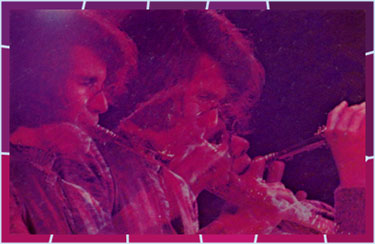 So, if you look at bar 2, in the 5-note grouping, you will see a configuration of notes, F-E-Eb-F, and that particular little phrase appears in this solo a total of 19 times!!! I won't point them all out but, on Pg. 1 alone, it appears in bars: 2, 24, 32, 38, 41, and 46. Make of that what you will!!! So, if you look at bar 2, in the 5-note grouping, you will see a configuration of notes, F-E-Eb-F, and that particular little phrase appears in this solo a total of 19 times!!! I won't point them all out but, on Pg. 1 alone, it appears in bars: 2, 24, 32, 38, 41, and 46. Make of that what you will!!!At bar 15, the faster bursts of notes begin to appear, and if you look down the page, it almost seems like those bursts happen every 4-bars or so. I would imagine that this is not intentional, it's just the way that Steve is feeling time and feeling his way through this endless shuffle on one chord. You'll also notice that his phrases usually end with a forcefully played short note, often an Ab or a Bb! And, those notes usually sit right on one of the quarter notes, so he's certainly feeling Billy Cobham's groove! In bar 19, with another long held C-natural, he begins one of my favorite phrases in this entire solo. By singing-out on that long C-natural, he makes it all the more effective when, at the end of bar 20, after surrounding it with consonant lower and upper neighbors(Bb & C), he plays a B-natural(b9), and to these ears, that caught my interest right away back in 1970! As this line cascades down, he puts brief emphasis on a Gb(#5), and on an E(b5). The resolution of the line, in a sense, mirrors how it began, as he surrounds the Bb(Root) with its chromatic upper neighbor, that same B-natural(b9), and D(3rd). In bars 23-24, as the next flurry begins, he sings-out an Ab and chromatically passes down to Gb again. As he did in the previous flurry, that Gb is followed by a D-natural, and back up to an F-natural just as he did before, except it was an octave higher. In bar 25, of this passage, we see for the 1st time during the solo, a grouping of 4-notes that many students of this great music would associate with John Coltrane and his famous "Giant Steps" solo. Here, in this tonality, Steve Grossman plays Eb-F-G-Bb during this line. Intervallically, it is the 1-2-3-5. Believe it or not, this configuration of notes appears 10 times during the solo. Notice in that long line, between bars 24-26, how he alternates the usage of his Db's and D-naturals to create tension, making the final resolution to Bb such a relief. In the long phrase that follows, beginning in bar 27, he sings out a G-natural(6th or 13th), remember that he had just placed so much emphasis on an Ab! The flurry in bar 29 vaults up to a high Db, a real blue-note, but he cadences on two more consonant pitches, Eb-Ab. The little phrase at the end of bar 31 into bar 32 is very much reminiscent of the opening phrase of the solo that landed on a C-natural(9th). And for the next 5 bars, he places a greater emphasis on C's and Bb's. It is at this point that, for quite a time, Billy Cobham stops playing, and it's just Steve Grossman alone with electric bassist Michael Henderson's shuffle groove. Perhaps Miles directed Billy to stop? Perhaps, Billy just decided to do that? Or perhaps, Teo was able to fade-out the drums? Letter [B] has arrived, and, in bars 2-3, he revisits a portion of the phrase that I liked so much in bars 21-22 of [A]. This leads to another great linear moment. Remember, he has just completed a line with the configuration B-natural-D-natural-Bb-Ab. That configuration begins 1/2-step above the eventual "target" note of Bb. In bar 5, he begins another nice line configuration where the first note, an A-natural, is about as outside as you can get on a dominant 7th chord, because it is the major 7th and shouldn't be there at all. But, listen to how Steve sings out that note, as if it is nothing out of the ordinary, and surrounds the target note of the very consonant F-natural(5th) with F#-A. The same intervals that preceded the Bb!!! This is beautiful and creative phrasing! As Page 2 of the solo arrives, and we just take cursory scan, looking over the entire page, it becomes obvious that the amount of linear activity, the density of the notes increases greatly. And, it's interesting to note that, for the most part, Grossman tends to pause every 4 bars. You will notice that the first 5 phrases all begin on an Ab! Steve must have liked the sound of that note, that day! On beat 4 of bar 12 of [B], once again, we see Grossman put to use an A-natural(maj7) over the Bb7 chord. It goes by very quickly, but it certainly tweaks the ear. It's hard not to hear that note! In bar 5, he's putting to use a lot of Db's, and that phrase contains notes that one could attribute to either the Bb blues scale, or Bb minor pentatonic[Bb, Db, Eb, F, Ab]. Bars 20-23 offer a fantastically snaky line configuration with some wonderful linear twists in bar 10. Notice the tones(F# & D) that he employs to surround the now familiar F-Eb-E-F grouping, but this time it's followed by the Trane-esque grouping one 1/2-step above where we've been hearing it. Now he plays E-F#-G#-B instead of Eb-F-G-Bb, pay special attention to how great that sounds, especially when he quickly resolves it to a G-natural on beat 3. At the very end of this phrase, he concludes by restating the line from bars 21-22 of [A]: E-D-Ab-D - B-natural-D-Bb! At the end of bar 27 in [B], he again alludes to a part of the blues scale by using Eb's and Db's. Then, in bars 17-19, he presents the stark contrast of how D-natural(3rd) can sound. In the blues, playing the 3rd, so dead-on, could often be perceived as a very vanilla choice of notes, but here, it sounds great because of Steve's skillful usage of it. From the end of bar 28 through bar 30, he again uses the same line configuration F-Eb-E-F to Eb-F-G-Bb, and then vaulting up to a high Gb(#5). 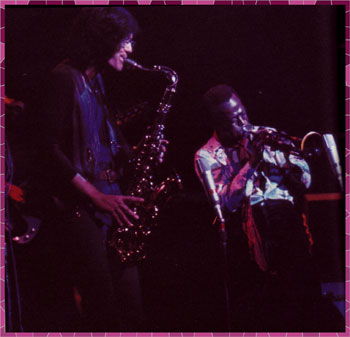 This also becomes a striking note, because it has not appeared in such an exposed way prior to that moment, and that's what makes it so effective. There are those who might hear this as an ugly note choice, or an out note, but it sounds beautiful to me. The next line, in bar 33, begins on that same Gb, and, as he winds his way downwards, he lands on a Gb, an octave lower and, in context, it sounds wonderful too. The phrase finally concludes as he puts to use the configuration of F-Eb-E-F to Eb-F-G-Bb, but this time it connects to more blues scale or Bb minor pentatonic usage that finally puts us 'home' on a Bb in bar 36. Bar 38 also offers a familiar line shape of Grossman's beginning on a G-natural(6th)-Gb to F-Eb-E-F, and resolving to a D-natural(3rd). In bar 39, he is completely sideways to the tonality of Bb and, for a moment, appears to be one 1/2-step above, as if playing in B7. Notice the grouping of: F#-A-B-A-D-B. Then, using a first inversion G-triad for transition, he vaults up to a high B-natural, and then drops down the 1/2-step to bring us home to Bb, our root!!! But, the full phrase is not complete until he again snakes his way down from an Ab, via a most circuitous route, passing from Ab-Gb-D-B to E-C-Ab-C with the latter four notes being a part of Bb7(9b5) chordal sound. All this eventually resolves to the 3rd(D-natural) of our fundamental sonority, Bb7. That D-natural was, yet again, preceded by the now very familiar configuration of: G-natural(6th)-Gb to F-Eb-E-F. This also becomes a striking note, because it has not appeared in such an exposed way prior to that moment, and that's what makes it so effective. There are those who might hear this as an ugly note choice, or an out note, but it sounds beautiful to me. The next line, in bar 33, begins on that same Gb, and, as he winds his way downwards, he lands on a Gb, an octave lower and, in context, it sounds wonderful too. The phrase finally concludes as he puts to use the configuration of F-Eb-E-F to Eb-F-G-Bb, but this time it connects to more blues scale or Bb minor pentatonic usage that finally puts us 'home' on a Bb in bar 36. Bar 38 also offers a familiar line shape of Grossman's beginning on a G-natural(6th)-Gb to F-Eb-E-F, and resolving to a D-natural(3rd). In bar 39, he is completely sideways to the tonality of Bb and, for a moment, appears to be one 1/2-step above, as if playing in B7. Notice the grouping of: F#-A-B-A-D-B. Then, using a first inversion G-triad for transition, he vaults up to a high B-natural, and then drops down the 1/2-step to bring us home to Bb, our root!!! But, the full phrase is not complete until he again snakes his way down from an Ab, via a most circuitous route, passing from Ab-Gb-D-B to E-C-Ab-C with the latter four notes being a part of Bb7(9b5) chordal sound. All this eventually resolves to the 3rd(D-natural) of our fundamental sonority, Bb7. That D-natural was, yet again, preceded by the now very familiar configuration of: G-natural(6th)-Gb to F-Eb-E-F.As the solo is close to winding down, he plays a long Eb in bar 43, and then, right up a 1st inversion of a Bb triad. At this point in the solo, something so consonant and simple is perhaps a great relief? In bar 49, as the last really long line begins, the most familiar configuration of this solo reappears: F-Eb-E-F to Eb-F-G-Bb, but this time, in bar 50, it feels as though Grossman is going to be in a more Bb minor pentatonic area, but just as soon as the ear expects more of that? After Db-Ab-Db, what should appear but, of all things, B-natural-C#-B, and for 2 beats, he has again given the impression of playing in B7, a 1/2-step above the root. Yet, he finds his way back to an F-natural on beat 4, and surrounds that note with a most consonant D-natural, and we're back home in Bb7. Just after this phrase, we begin Letter [C], as Billy Cobham and his big backbeat reappear! In bar 2, Steve sings out a long Ab, and then, after a very brief whole-tone moment: Gb-Ab-Gb-E-Gb, giving more weight to the pitch of Gb(#5), he vaults up to a C-natural, not unlike what he played during the 1st 4-bars of the solo! He closes out with a line that embodies the two principal linear units that have appeared and reappeared throughout. It's a perfect ending to an in-the-moment improvised exploration. Though I had been New York since January of 1970, I sadly did not cross paths with Steve Grossman as much as I would have liked. We seemed to travel in different social circles outside of music. But I know that he was a very highly regarded and respected player by all his peers. There were those, in and outside of that circle of musicians and friends who referred to Grossman, like Dave Liebman, Michael Brecker and Bob Berg, as the "Jewish Coltranes." Though I have stated this before at these pages, all I wanted to do was to play Jazz, or whatever Jazz was becoming back then - which certainly had it headed in the Fusion direction. I had saved-up as much money as I could before my move, and felt that I could survive 3 years without having to play any "bad" music. How could I have 'planned' that I would be arriving in New York around the same time as all these great musicians, who were all destined to become legends in the years that were to come? It was the greatest act of good fortune anyone could have bestowed upon another human being. During this early portion of the '70s, many of us, I believe including briefly Steve Grossman, belonged to an organization, founded by Dave Liebman, and known as, Free Life Communication, which was dedicated to promoting our music from within, and a better communication and understanding between musicians and all the arts. We jammed together in lofts and other spaces in various configurations night after night, talked about music, listened to music, and generally, we just lived music all the time. I believe that everyone's story is very much the same within degrees. I don't know of ANYONE, within that group of players, who came to New York to do anything less than to try to become a better musician, and hopefully participate in great music, great art. For the players that I was close to, we all had similar dreams and goals. The point I'm trying to state in a different manner is that, I am certain that when Miles Davis phoned Steve Grossman, Steve was not envisioning himself playing soprano sax all the time, and wailing over one chord dominant 7th vamps. 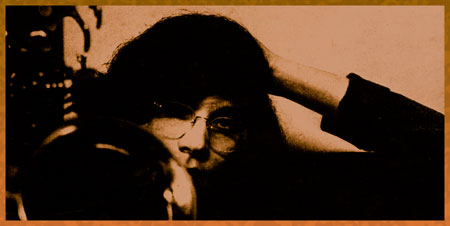 So, it would be my sense that his recollections of this moment during "Right Off" might be fraught with countless other feelings than the music that he left behind for us that day. So, it would be my sense that his recollections of this moment during "Right Off" might be fraught with countless other feelings than the music that he left behind for us that day.While frantically looking for another piece of photocopied music, and rummaging through some of the stacks of music papers strewn about this apartment, quite by accident, I stumbled upon this particular solo transcription and felt that this might finally be the perfect moment to share it. When students come to me for study and lessons, among the common musical desires expressed to me is something like this: "Steve, I just want to be able to play some of the things that I hear in my head without such great difficulty. Oh, and I'd love to be able to play more 'out' if that was possible too." Well, I do have a particular philosophy and method that I believe in, because it helped me, and I have seen this method succeed with any number of students who trusted me enough to follow along with it and see it through. It actually involves improvising, soloing over one chord, especially in the three most important chord families: major, minor and dominant. The idea is to become so conversant at hearing the 'correct' 7 modal tones, and improvising freely with them so that one is comfortable, and plays what is natural for them. In other words, they begin to hear what they are playing. As the process moves along, chromaticism is judicially added, so that the very particular language of Jazz becomes a part of what they play. Again, this is the area of the process that is really just dealing with consonant sounds. Depending upon that person's progress, and each person is different, eventually, over time, we arrive at the introduction of pitches/tones that would appear to be outside of the tonal center. It's not always easy to convey this, because it's crucial that one has a personal and emotional relationship with those pitches too. So, how does one arrive there? That's the issue, and that is one of the specific reasons for sharing this wonderful Steve Grossman solo from "Right Off." Each of the other worldly tones that Grossman played during this solo were arrived at by means of one of the greatest linear devices, and that is the usage of neighboring tones, both upper and lower, consonant and chromatic. If you go back and review the specific tones that I pointed out during this analysis, you should find that this idea is in full play. I suppose that it is not so ironic that the only other one chord solo offered at KORNER 1 is transcription 44, Michael Brecker's soprano sax solo over Hal Galper's tune, "Call." Michael hated playing the soprano sax, because that damn instrument is so hard to keep in tune! Perhaps that's why, several times in his life, he accidentally on purpose left them in various taxis here in New York City, and around the world! As we have arrived at the new year of 2013, I wanted to wish everyone who visits these pages the best of everything and offer my most sincere "Thanks!" for your wonderful messages and encouragement!!! Enjoy this Steve Grossman transcription with my best wishes!!! Addendum: Because I became so curious as to just what actually happened during Steve Grossman's solo, I decided to go to Amazon.com, and purchase "THE COMPLETE JACK JOHNSON SESSIONS" in hopes that, just by listening carefully, I could unearth the truth about whether or not Billy Cobham stopped playing during Steve's solo, or, was he faded-out by Teo Macero's multi-track editing process. In total, the CD booklet tells us that there were four takes, or partial takes, with timings that totaled: 30:30. Again, the actual performance as we all heard it on the original album, one side of an LP, has always been listed at 26:52, which means that some 4:38 were not used for one reason or another. 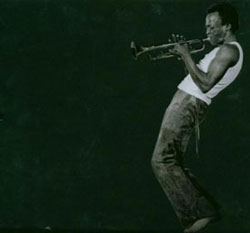 Another question for me was, would we hear these takes just as they were played? No editing, no fading in and out, etc.!!! Another question for me was, would we hear these takes just as they were played? No editing, no fading in and out, etc.!!!And the answer is "Yes!" We do get to hear the takes as listed on the "track sheets" without any fades or editing. As it turns out, Grossman's solo actually happened during what was labeled within the Box Set as "Take 10A" which only lasts about 4:34, and was the 2nd of the first two takes. And, after listening to the full, unedited version, I learned that, other than fading-in the solo on the LP version, there really was no other Teo Macero trickery or magic. And the take confirms that Billy Cobham just either stopped playing as I pointed-out in my analysis, or Miles instructed Billy to stop playing. That is not explained during the extensive liner notes, and apparently Billy Cobham was interviewed about his memories of that day. Just to be faithful to the full solo, I was better able to hear the very 1st Phrase that Steve played, and you can view it via the link that I have provided. It's a shame that this phrase was not better included within the original edit. In some ways, it was completely in keeping with thematic units that he employed throughout, but, the fact that, in bar 2, after he's played that first long Bb, he vaults up to an E-natural(b5), but then he follows that note with a B-natural(b9). For most ears, these are certainly two notes that are outside of what one might be used to hearing over a dominant 7th rock-style shuffle. Of course, I would think that these sounds are rather normal, or even ordinary to a great saxophonist steeped in the grand tradition. Going back to bars 1 & 2, you see that he descends to F-natural via Ab-Gb. One could analyze the presence of the Gb as if those three notes together could be considered a part of F7(#9-b9) pulling back to Bb7. It's also possible to view both E-natural & B-natural as part of F# Dorian, or part of a sideways ii-V(F#m7-B7) which also would pull back towards a resolution on Bb7. However, I think that to even consider such a thing is just over-analyzing! The best thing to do would be to simply enjoy the sounds that he created. But, it is now interesting to note that, as abstract as Grossman might have begun, he really stayed away from E's and B's until bars 20-22. The only other really fascinating detail involving Steve Grossman and "Right Off" is that, on what is labeled as "Take 12," the band has now returned to vamping on E7(sus), and Steve plays a 2nd solo in that key area, which is, of course, either F#7/Gb7 for him on the saxophone, which must transpose up a whole-step. The solo lasts from 3:45-5:26. After a lyrical beginning, he plays more in the "sheets of sound" style, as renowned Jazz journalist, Ira Gitler once described the great John Coltrane's playing. As I pointed-out earlier, when you listen to this 2nd improvisation, pay close attention to the long, held notes, you might well learn more from that than anything else. Those long tones were played with conviction, passion and emotion!!!
[Photo: Steve Grossman w/ Dave Holland and Miles Davis
Photo: Steve Grossman from Miles Davis' "LIVE AT THE FILLMORE EAST" by Jim Marshall Photo: Steve Grossman live w/ Miles Davis by David Redfern Photo: Steve Grossman from back cover of Chick Corea's LP, "THE SUN"(1970) courtesy of Swing Journal] |